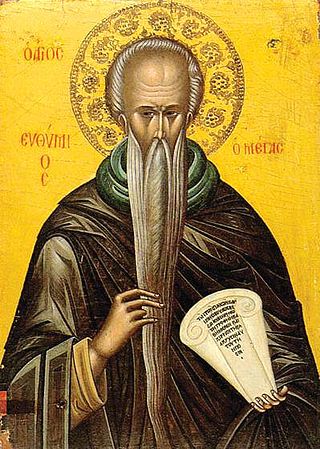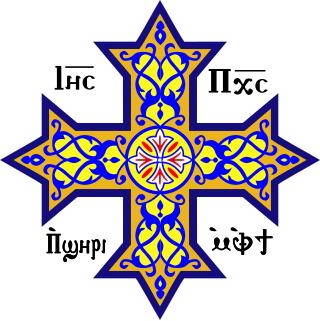Christian monasticism first appeared in Egypt and Syria. [1] This is a partial chronology of early Christian monasticism with its notable events listed. It covers 343 years.
| Year (AD) | Historical event |
|---|---|
| c. 227 | Paul the Great is born. He is considered to be the very first Christian eremitic ascetic. He lived very reclusively and was only discovered by Anthony towards the end of his life. [2] |
| 249-51 | Persecution of Christians under Emperor Decius forces many Christians to flee into the desert (including Paul the Great [2] ), thus starting Egyptian Christian monasticism. [3] [4] |
| c. 251 | Anthony the Great is born, who is considered to have founded eremitic monasticism. [5] [4] [1] |
| c. 285 | Cronius of Nitria is born. [4] |
| c. 290 | Pachomius the Great is born, who is considered to have founded cenobitic monasticism. [6] [7] [4] |
| 291/292 | Hilarion the Great is born, who was inspired by Anthony. [8] |
| 293 | Athanasius the Great is born. His writings are important for the start of Christian monasticism. [9] [1] |
| c. 300 | Macarius the Great is born. [10] [4] |
| 303 | Christian persecution under emperor Diocletian: the Diocletianic Persecution. [11] [4] |
| 305 | Anthony the Great relocates from the Outer Mountain to the Inner Mountain of Pispir. [12] |
| 306 |
|
| c. 310-20 | Athanasius the Great begins his ecclesiastical career. [12] |
| 313 | The Edict of Milan legalizes Christianity and ends persecution. [15] |
| 314 |
|
| c. 315 |
|
| c. 320 |
|
| 320 | Pishoy is born. |
| c. 323 | |
| 324 | Constantine the Great becomes the sole emperor of all of Rome. [4] [13] |
| 325 | First Ecumenical Council of Nicaea. [4] [18] [19] |
| 328 | Athanasius the Great becomes Archbishop of Alexandria. [4] [9] |
| 329 | Basil the Great is born. He influences Christian monasticism by his ascetic writings. [20] |
| 330 |
|
| 337 | Death of Emperor Constantine (as a Christian). [13] [4] |
| 338 | |
| 339 | John the Dwarf is born in Thebes. |
| c. 340 |
|
| c. 341 | Death of Paul the Great in Thebes. |
| c. 345 | Rufinus is born. [26] |
| 346 | Death of Pachomius the Great. [7] [6] |
| c. 347 | Jerome is born. [27] |
| 347 | John Chrysostom is born. [28] |
| 356 |
|
| 357 | Athanasius of the Great writes his biography of Anthony the Great. [30] [31] |
| c. 358 | Death of Serapion of Nitria. |
| 360 | John Cassian is born. |
| 361 | Julian the Apostate becomes the emperor of Rome. [32] [4] |
| 362 | 4th exile of Athanasius the Great by Julian the Apostate. [9] [12] |
| 363 | Death of Mar Awgin (a Syrian disciple of Pachomius the Great). He had established Christian monasticism in Mesopotamia. [1] |
| 364 | 5th and final exile of Athanasius the Great. [9] |
| 367 | Epiphanius becomes the bishop of Cyprus. [4] [33] |
| 368 | Death of Theodorus of Tabennese. |
| 370 | Basil the Great, Archbishop of Caesarea, writes his Rules which becomes an important monastic text. [4] |
| 371 | Death of Hilarion the Great. |
| 373 |
|
| 373-5 | Rufinus meets Melania in Egypt. [4] |
| 375 | Death of Pambo. [34] [4] |
| c. 376 | Jerome writes his Life of Paul of Thebes. [12] |
| 377 | Euthymius the Great is born. [35] |
| 379 | Death of Basil the Great. [36] [4] |
| 380 | At Gaza, Silvanus and a certain Mark the Calligrapher make a settlement. [37] |
| 381 | First Ecumenical Council of Constantinople. [38] [4] |
| 382 | Jerome returns to Rome. [12] |
| 383 | Evagrius of Nitria becomes a monk at Kellia. [4] [39] |
| 385 | |
| c. 386 | Death of Cronius of Nitria. [4] |
| c. 390 | Jerome writes his Life of Malchus. [12] |
| 390 |
|
| 391 | |
| 394-5 | Death of John of Lycopolis. [41] |
| 395 |
|
| 398 | John Chrysostom is ordained the Archbishop of Constantinople. [28] [4] |
| 399 |
|
| c. 400 |
|
| c. 404 | John Cassian establishes the first Egyptian-style monastery in Gaul. [45] |
| 405 |
|
| 407 | |
| 407-408 | |
| 410 | Rome is sacked by Alaric and the Visigoths. [49] [4] |
| 411 |
|
| 417 | Death of Pishoy on July 15. |
| c. 419-20 | Palladius writes his Lausaic History . [50] [4] |
| 421-6 | John Cassian writes the Institutes and the Conferences. [4] [51] |
| 429 | Death of Sisoes the Great. |
| 431 | Ecumenical Council of Ephesus. [4] [52] |
| 434 |
|
| c. 435 |
|
| 439 | Sabbas the Sanctified is born. [4] [55] |
| 444 | 3rd destruction of Scetis. [47] |
| 445 | Death of Arsenius the Great. [4] [53] |
| 449 | Death of Daniel of Egypt, disciple of Arsenius the Great. [4] |
| 450 |
|
| 451 | Council of Chalcedon. [58] [4] After the Council of Chalcedon, the decision was made to put all Egyptian monasticism under church hierarchical supervision. This marked the end of the classical era of early Egyptian Christian monasticism. [59] |
| 455 | Rome under, Emperor Romulus Augustus, is sacked by the Vandals. [60] [4] |
| 459 |
|
| c. 480 | Birth of Benedict of Nursia who greatly shaped western monasticism ("Benedictine" monks). [62] [4] |
| 484 | The Great Lavra (Mar Saba) is founded by Sabbas the Sanctified. [63] |
| 491 |
|
| ca. 520 | Foundation of the monastery of Seridus by abbot Seridus of Gaza. [64] |
| 527 | Saint Catherine's Monastery is founded on Mount Sinai by Emperor Justinian the Great. [65] |
| c. 543 | Death of Barsanuphius and John the Prophet, two hermits who wrote over 800 letters of spiritual guidance to monks, priests and lay people. Their disciple Dorotheus of Gaza goes on to found a new monastery. [66] |
| 570 | 4th destruction of Scetis. [47] |









